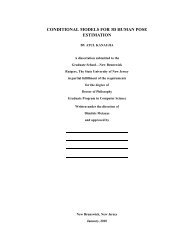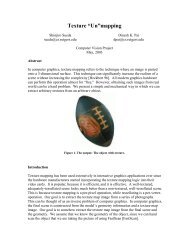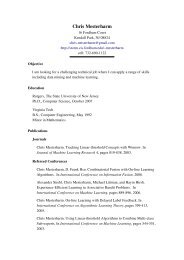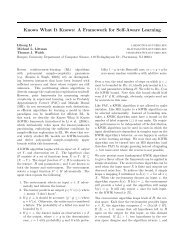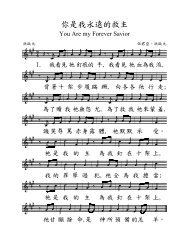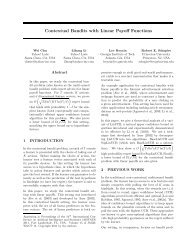Composition theorems in communication complexity
Composition theorems in communication complexity
Composition theorems in communication complexity
Create successful ePaper yourself
Turn your PDF publications into a flip-book with our unique Google optimized e-Paper software.
Theorem 5 (Nisan [Nis94], Buhrman-Cleve-Wigderson [BCW98]). For any two<br />
Boolean functions f : {−1, +1} n → {−1, +1} and g : X × Y → {−1, +1},<br />
D(f ◦ g n ) = O(DT(f)D(g))<br />
R 1/4 (f ◦ g n ) = O(RT 1/4 (f)R 1/4 (g) log RT 1/4 (f))<br />
Q 1/4 (f ◦ g n ) = O(QT 1/4 (f)Q 1/4 (g) log n).<br />
One advantage of work<strong>in</strong>g with block composed functions <strong>in</strong> light of this upper bound<br />
is that query <strong>complexity</strong> is <strong>in</strong> general better understood than <strong>communication</strong> <strong>complexity</strong>.<br />
In particular, a polynomial relationship between determ<strong>in</strong>istic query <strong>complexity</strong> and degree,<br />
and randomized and quantum query complexities and approximate degree is known.<br />
Theorem 6 ([NS94,BBC + 01]). Let f : {0, 1} n → {−1, +1}. Then<br />
DT(f) = O(deg(f) 4 ), DT(f) = O(deg 1/4 (f) 6 )<br />
Us<strong>in</strong>g this result together with Theorem 5 gives the follow<strong>in</strong>g corollary:<br />
Corollary 1.<br />
D(f ◦ g n ) = O(deg(f) 4 D(g)),<br />
R 1/4 (f ◦ g n ) = O(deg 1/4 (f) 6 R 1/4 (g) log deg 1/4 (f))<br />
Our goal, then, <strong>in</strong> show<strong>in</strong>g lower bounds on the <strong>complexity</strong> of a block composed function<br />
f ◦ g n is to get someth<strong>in</strong>g at least <strong>in</strong> the ballpark of this upper bound. Of course, this is<br />
not always possible — the protocol given by Theorem 5 is not always optimal. For example,<br />
when f is the PARITY function on n bits, and g(x, y) = ⊕(x, y) this protocol just gives an<br />
upper bound of n bits, when the true <strong>complexity</strong> is constant. See recent results by Zhang<br />
[Zha09] and Sherstov [She10] for discussions on the tightness of the bounds <strong>in</strong> Theorem 5.<br />
3 Rank of block composed functions<br />
We beg<strong>in</strong> by analyz<strong>in</strong>g the rank of a block composed function f ◦ g n when the <strong>in</strong>ner function<br />
g is strongly balanced. This case will illustrate the use of the strongly balanced assumption,<br />
and is simpler to understand than the bounded-error situation treated <strong>in</strong> the next section.<br />
Let us first formally state the def<strong>in</strong>ition of strongly balanced.<br />
Def<strong>in</strong>ition 5 (strongly balanced). Let A be a sign matrix, and J be the all ones matrix<br />
of the same dimensions as A. We say that A is balanced if Tr(AJ † ) = 0. We further say<br />
that A is strongly balanced if AJ † = A † J = 0. In words, a sign matrix is strongly balanced<br />
if the sum over each row is zero, and similarly the sum over each column is zero. We will<br />
say that a two-variable Boolean function is balanced or strongly balanced if its sign matrix<br />
representation is.<br />
Theorem 7. Let f : {−1, +1} n → {−1, +1} be an arbitrary function, and let g be a strongly<br />
balanced function. Then<br />
∑<br />
rk(M f◦g n) =<br />
rk(M g ) |T | .<br />
T ⊆[n], ˆfT ≠0<br />
Proof. Let us write out the sign matrix for χ T ◦ g n explicitly. If we let Mg<br />
0 = J be the<br />
all ones matrix and Mg<br />
1 = M g , then we can nicely write the sign matrix represent<strong>in</strong>g<br />
χ T (g(x 1 , y 1 ), . . . , g(x n , y n )) as<br />
M χT ◦g n = ⊗ Mg<br />
T [i]<br />
i


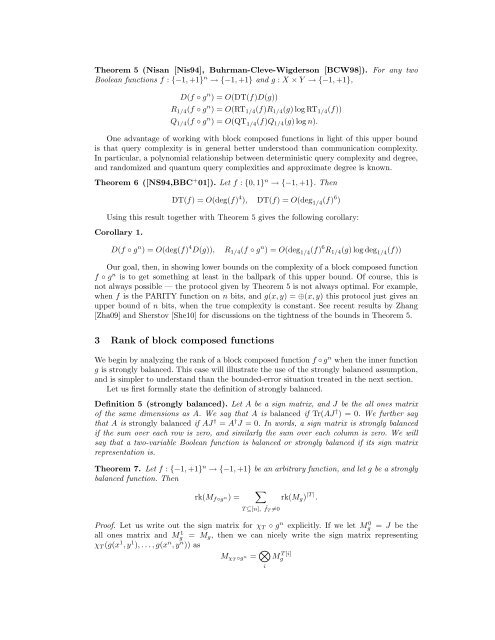
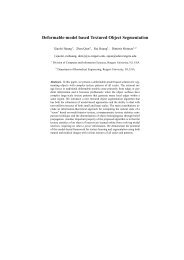
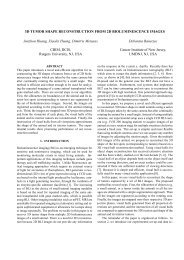
![Twitter[PDF]](https://img.yumpu.com/25710531/1/190x143/twitterpdf.jpg?quality=85)
